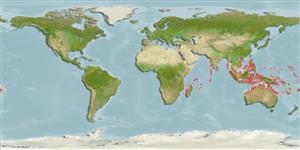Common names from other countries
>
Acanthuriformes (Surgeonfishes) >
Acanthuridae (Surgeonfishes, tangs, unicornfishes) > Acanthurinae
Etymology: Acanthurus: Greek, akantha = thorn + Greek, oura = tail (Ref. 45335).
More on author: Randall.
Environment: milieu / climate zone / depth range / distribution range
Écologie
marin récifal; profondeur 1 - 20 m (Ref. 90102). Tropical; 20°N - 25°S, 35°E - 172°W
Western Indian Ocean: Mozambique (Ref. 41878). Indo-West Pacific: Seychelles (Ref. 10685), Philippines, Indonesia and Great Barrier Reef; recently found in Maldives. Reported from Malaysia (Ref. 5756) and Samoa (Ref. 592).
Taille / Poids / Âge
Maturity: Lm ? range ? - ? cm
Max length : 45.0 cm SL mâle / non sexé; (Ref. 48637); âge max. reporté: 30 années (Ref. 52229)
Épines dorsales (Total): 9; Rayons mous dorsaux (Total): 25-26; Épines anales 3; Rayons mous anaux: 23 - 24. Color in life dark brown; orange brown from pectoral base downward; caudal spine socket bright orange; orange blotch before and behind pupil; caudal fin base with a white band. Anterior gill rakers 20-23, posterior 24-28. Large caudal spine, 2.2 - 4.4 in head.
Adults inhabit shallow reefs, both in lagoons and outer reef areas. They frequently move in groups. Juveniles found between soft corals in lagoons at depths of up to 2 m (Ref. 9710, 48637). Adults in groups, often mixed with other similar species (Ref. 48637).
Life cycle and mating behavior
Maturité | Reproduction | Frai | Œufs | Fécondité | Larves
Randall, J.E., 1956. A revision of the surgeonfish genus Acanthurus. Pac. Sci. 10(2):159-235. (Ref. 1920)
Statut dans la liste rouge de l'IUCN (Ref. 130435)
CITES (Ref. 128078)
Not Evaluated
Menace pour l'homme
Harmless
Utilisations par l'homme
Pêcheries: commercial
Plus d'informations
Noms communsSynonymesMétabolismePrédateursÉcotoxicologieReproductionMaturitéFraiFéconditéŒufsDéveloppement de l'œuf
RéférencesAquacultureProfil d'aquacultureSouchesGénétiqueElectrophoresesHéritabilitéPathologiesTraitementMass conversion
CollaborateursImagesStamps, Coins Misc.SonsCiguateraVitesseType de nageSurface branchialeOtolithesCerveauxVision
Outils
Articles particuliers
Télécharger en XML
Sources Internet
Estimates based on models
Preferred temperature (Ref.
115969): 25.6 - 29.3, mean 28.5 (based on 2408 cells).
Phylogenetic diversity index (Ref.
82804): PD
50 = 0.5000 [Uniqueness, from 0.5 = low to 2.0 = high].
Bayesian length-weight: a=0.02344 (0.01103 - 0.04981), b=2.96 (2.79 - 3.13), in cm Total Length, based on LWR estimates for this Genus-body shape (Ref.
93245).
Niveau trophique (Ref.
69278): 2.0 ±0.1 se; based on size and trophs of closest relatives
Résilience (Ref.
120179): Faible, temps minimum de doublement de population : 4,5 à 14 années (tmax=30; K=0.67).
Fishing Vulnerability (Ref.
59153): Low to moderate vulnerability (26 of 100).
